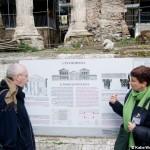ABOUT ME
My name is Flavia. I was born and raised in Rome and I have lived here all my life (the little girl at the Colosseum on the home page is me at 2 years old!) .
After my University studies as an Interpreter and Translator, I started working as a Tour Manager in 1990, and travelled Italy and Greece with North American and British groups for 10 years.
In 2001 I passed the qualifying exam to practise as a Tourist Guide in Rome and its Province; I have been happily working as a guide since then.
I graduated in Archaeology in 2002.
In 2003 I taught Early Christian Archaeology and Architecture as adjunct professor at St. John’s Seminary, Boston (USA), for their European Spring term.
In 2010 I specialized (post-graduate) in Early Christian and Medieval Archaeology.
In July 2013 I earned the qualification (post-graduate) to teach Art History, and in February 2015 I started teaching Art History in public highschools.
I taught a 3-week course on Art and Culture in Rome through the centuries in June 2015 and a 4-week course on Roman History and Archaeology in July 2016 at Richmond University in Rome. I believe in sustainable tourism, and love off-the-beaten-track treasures, and any underground site!
I am a member of ANGT-Associazione Nazionale Guide Turistiche (National Association of Tourist Guides) and of AGTAR-Associazione Guide Turistiche Abilitate Roma (Association of Qualified Tourist Guides of Rome).
I am on Facebook at https://www.facebook.com/archaeowalks
The website’s logo is my interpretation of the so called “Gradiva”, literally “she who walks”. Gradiva is actually part of an ancient marble relief, an ancient Roman replica from a Greek original of the IV century BC, today at the Vatican Museums, Rome. It probably originally portrayed three women moving from the right associated to other three women mirroring them: the Horae (goddesses of the seasons and the natural portions of time) and the Aglaurids (deities of the nightly dew). This elegant walking woman inspired German writer W. Jensen: he called her Gradiva (after Mars Gradivus, the Roman god of war “walking through the battle”), and wrote the novel “Gradiva. A Pompeian Fantasy” (1903). Jensen’s novel later inspired S. Freud’s essay “Delusion and Dream in Jensen’s Gradiva” (1906). Art historian A. Warburg also wrote a paper on her. Both Jensen and Freud owned a cast of this relief (in Freud’s office it was on the wall above the famous couch!).





